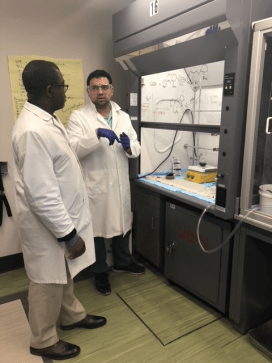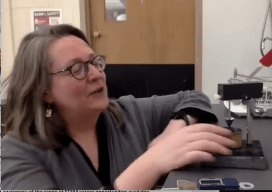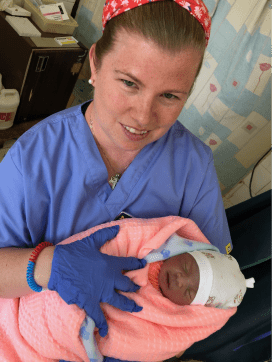Equity Project Spotlight: Workforce Stories for Adolescents Who Are Deaf or Hard of Hearing
PI: Judy Vesel
Primary Organization: TERC
Award Number: 2005511
Project Title: STEM Workforce Stories for Adolescents Who Are Deaf or Hard of Hearing
Judy Vesel, TERC, shares more about the STEM Workforce Stories for Adolescents Who Are Deaf or Hard of Hearing (NSF Award #2005511).
What is your project’s big idea?
While progress has been made in broadening participation of underrepresented groups in STEM, data shows that persons with disabilities remain underrepresented in STEM education and employment compared to their representation in the U.S. population. Individuals with disabilities experience a lower level of career success when compared to their nondisabled peers and are less likely to complete a college education. Persons who are deaf or hard of hearing often have little or limited awareness of the range of STEM career opportunities available or of examples of persons who have pursued and succeeded in STEM careers. Given the lack of available resources, there is a pressing need for the research and development of the STEM workforce stories. Addressing this will support the next generation of deaf or hard of hearing members of the STEM workforce.
The STEM Workforce Stories are seven career stories told by the deaf or hard of STEM professionals. Stories are delivered as videos for use in out-of-school settings and include a broad range of STEM professionals of all ages including teachers, technicians, and researchers. These stories contribute to middle and high school students’ awareness of the range of STEM careers that are available and of their potential ability to pursue and succeed in a STEM career.
Our project aimed to answer five primary research questions:
- How do parents, club, and teacher leaders make use of the stories?
- How do adolescents who are deaf or hard of hearing integrate and use digital versions of firsthand stories from members of the STEM workforce?
- What kinds of outcomes are made possible with use of the stories in terms of interest and engagement in STEM and pursuing a STEM career?
- What modifications and additions would improve the stories to make them more useful and effective?
- What strategies would maximize story use when sharing with wider communities?
The answers to the first three questions generated new knowledge about what happens with use of the stories, how it happens, and under what circumstances. Our answers to the last two questions are generating new knowledge about subsequent design and distribution of the stories.




What did your project do to find participants to share their stories?
To identify and select members of the STEM workforce to share their stories, the TERC team reached out to prospective candidates from a range of online sources. We explained in our request that these stories are intended to provide a snapshot of the experiences that led up to their career, what they do and where and how they do it, challenges they encountered, and how they responded to them.
We created a list of places that included organizations and persons we had previously worked with or were aware of as potential sources of participants and asked them to post the request. We contacted organizations including, but not limited to, Do-IT, The International Association for Geoscience Diversity, Hands & Voices, The National Technical Institute for the Deaf, Alexander Graham Bell Association for the Deaf, Atomic Hands, our project advisors, and personal contacts made during prior research and development. Several of these resulted in additional contacts that were also pursued. We invited eight participants to share their stories. based on availability during the taping period, and their profession, hearing status, and gender. The participants were excited about being selected to share their stories and participate in the project.



How were the stories used?
The objectives of the research component of the project are to study:
- How the stories are used during out-of-school time.
- The impact of the stories the target audience’s awareness of the range of STEM careers that are available to them and of their potential ability to pursue and succeed in a STEM career.
- How the stories might be improved and disseminated.
To see how the stories were used during out-of-school time, we reached out to communities about the project. We built trust within each community prior to them using the stories by sending families, clubs, and schools a note that included the viewing protocols and a Testing Consent Form.
Participants who are hearing and deaf used the interactive features in ways that met their individual needs. This showed the importance of providing users with options from which to choose. They could select a language or languages, alter volume, change the brightness of the screen and size of the text, replay sections, see captions, and view a transcript. The use and usefulness of each feature depended on the needs of the person doing the viewing.
Participating parents and teachers had adolescent participants view the stories alone. They assisted on an as-needed basis and discussed the stories together afterwards. Club leaders divided students into groups of three or more and paired each group with a leader. Each group watched the story together and discussed it afterwards.
What outcomes did your project find?
Adults’ and adolescents’ perceptions often differed in how the stories contributed to their interest and engagement in STEM and in pursuing a STEM career. As with use of the interactive features, the degree to which the stories were a factor was highly individual and depended on the person doing the viewing.
In general, the data shows that the stories positively contributed to increased interest of viewers who are deaf or hard of hearing in STEM and in possibly pursuing a STEM career. They also show that they generated an awareness of how to overcome challenges and obstacles along the way. An unexpected outcome was that hearing viewers found the stories valuable in that they increased their respect for persons who are deaf or hard of hearing and made them aware of the challenges they encounter and what they need to do to pursue what interests them and to realize their career goals.
To participate in the project or for more information, contact PI Judy Vesel at judy_vesel@terc.edu.